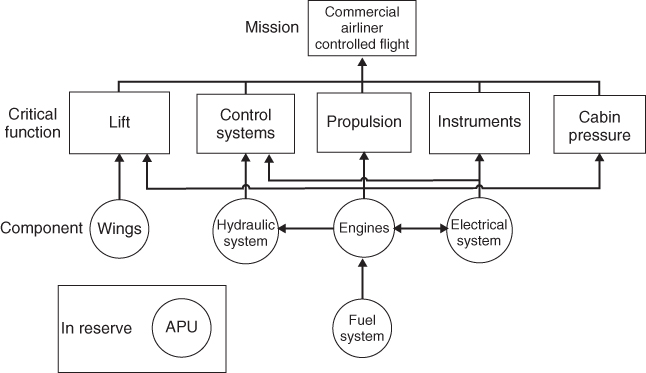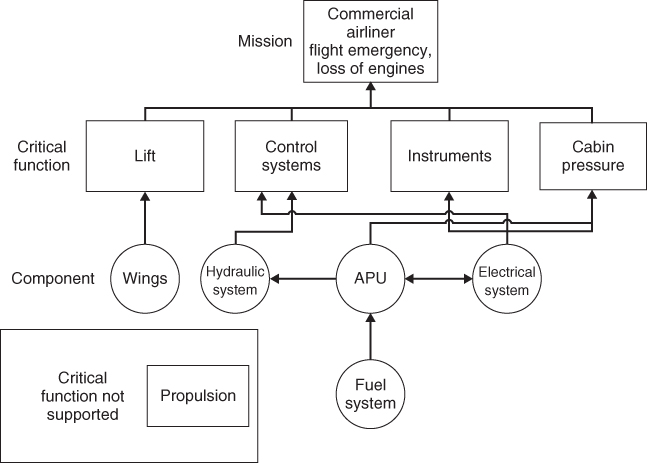13.2 Critical Functions
Obviously, in both these accidents, critical functions of the airplanes failed. In both the cases, they were hardware components. The human component in both accidents succeeded. The components of an airplane are listed in Table 13.3, along with the functions that failed or succeeded in each event.
Table 13.3 Critical Functions of a Commercial Airplane

It is apparent from Table 13.3 that critical functions are dependent on each other in modern commercial airliners. Figure 13.1 shows how these functions are interconnected. Figure 13.2 shows how the diagram would change if the engines failed, for instance.
Figure 13.1 Interconnection of critical functions.

Figure 13.2 Flight during an engine failure event.

CFA then can be used to determine which critical functions are needed to support the desired mission. A recent Web article on www.globalsecurity.org listed the flight critical systems for the F-22 Raptor (17). These are listed in Table 13.4.
Table 13.4 Flight Critical Systems for F-22 Raptor
| Flight critical system | Function |
| Vehicle management system (VMS) | The VMS provides integrated flight and propulsion control. The VMS enables the pilot to aggressively and safely maneuver the F-22 to its maximum capabilities |
| Utilities and subsystems (U&S) |
|
| Integrated vehicle subsystem controller (IVSC) | The IVSC is the system responsible for aircraft integration, control, and diagnostics |
| Environmental control system (ECS) | The F-22 uses a totally integrated ECS that provides thermal conditioning throughout the flight envelope for the pilot and the avionics |
| The five basic safety critical functions the ECS must take care of include avionics cooling, adequate air to the pilot, canopy defog, cockpit pressurization, and fire protection | |
| Air cycle system | The air cycle conditions air from the engines for various uses |
| Liquid cooling system | Unlike other fighter aircraft, the F-22 uses liquid cooling, rather than air cooling for the mission avionics |
| Thermal management system (TMS) | The TMS is used to keep the fuel cool |
| Fire protection | Fire protection is provided for the aircraft's engine bays, the auxiliary power unit (APU), and for dry bays |
| The aircraft uses infrared and ultraviolet sensor for fire detection and Halon 1301 for fire suppression | |
| Auxiliary power generation system (APGS) | The APGS consists of an APU and a self-contained stored energy system (SES) |
| Landing gear | The F-22 utilizes tricycle landing gear, with the standard two main gears (each with a single tire) and a single-wheel, steerable nose landing gear assembly |
| Fuel system | There are eight fuel tanks on the F-22, including one (designated F-1) in the forward fuselage behind the pilot's ejection seat. The others are located in the fuselage and the wings. The F-22 will run on JP-8, a naphthalene-based fuel with a relatively high flash point |
| Electrical, hydraulic, and arresting systems | The F-22 uses a Smiths Industries 270 V, direct current (DC) electrical system. It uses two 65-kW generators. The hydraulic system includes four 72 gal/min pumps and two independent 4000 psi systems |
An F-22 crashed in Alaska on November 16, 2011, killing the pilot (18). The cause of the crash was found to be the Bleed Air System, part of the Air Cycle System, which is listed above as one of the critical functions required by the F-22 to fly (19).
